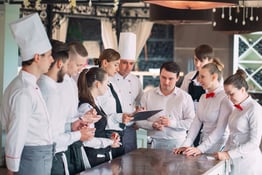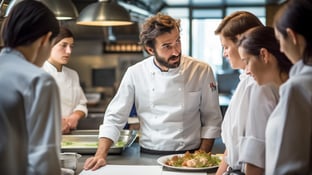Robots in restaurants are nothing new. In fact, many larger national chains have been using robotics to help automate repetitive kitchen tasks for years. However, as the technology advances, it is becoming increasingly common to see robots doing front-of-house tasks like running food and bussing tables.
But whatever you do, don’t call them robot waiters. Joey Scott, Food Distribution Partnerships Executive for Bear Robotics, prefers to think of his company’s robots as labor support tools. “We’re not looking to replace staff,” says Joey. “We're just looking to enhance what they're able to do.”
Bear Robotics is providing these enhancements through an AI-powered robot called Servi+. So we asked Joey exactly how innovations in robotics are helping to improve front-of-house operations throughout the food service industry.
Why We’re Seeing More Robots in Restaurants
It’s no secret that many restaurants struggle with the rising labor costs, recurring worker shortages, and high turnover. Joey can appreciate the impact of these challenges firsthand. “I've been in restaurant environments for 30 plus years,” says Joey, “working from server, bartender, really all the front-of-house and back-of-house positions.”
So when Joey talks about the value of technology like the Servi+, he understands just how important human servers are to the dining experience. Used correctly, robots in restaurants should empower rather than replace human workers.
Take it from Bear Robotics client Carlos Gazitua. The CEO of Sergio’s Franchise Group and Restaurant recalls that members of his staff were skeptical of the robot at first, “but now they feel like it’s an assistant that they can call on to help with the hard functions of the job – like your own personal forklift at the Home Depot, only it’s carrying plates.”
Since adding robots to his front-of-house team, Carlos says his servers have more time to engage with customers, which he says translates into higher tips and the ability to handle more tables at once.
How Robots In Restaurants Work
Restaurants can use robotics to do all kinds of tasks including drink service, food delivery, bussing, and escorting customers to their seats. In fact, the Servi+ even has a special setting for delivering soup at a slower pace so it doesn’t spill!
The Servi+ includes a vertical stack of four trays on wheels. Each tray has a weighted sensor that tells the robot when items have been placed on, or removed from, its surface. The robot also knows to move on to the next table or return to the kitchen after it has delivered its dishes.
The Servi+ includes lighting for individual trays and an LED display for programmed messaging, and it has the ability to say common restaurant floor phrases like “excuse me,” “please take your food,” and “happy birthday.” Members of your team can communicate instructions to the robot easily using an attached tablet screen.
How To Implement Robotics For Restaurants
Each Servi+ is fully customized around a restaurant’s unique space and needs. The Servi+ can “see” your restaurant floor by using a combination of front-facing, downward-facing, and upward-facing cameras, along with a laser sensor system called LiDAR.
Joey explains that “When we deploy robots, we have an engineer that can allocate up to two days at the location. They will come in and literally push the robot around the entire restaurant space to get a 2-D image. We then map your floor plan, table numbers and other key points in the robot’s programming.”
From here, explains Bear COO Juan Higueros, this map of your floor plan “becomes fixed in the robot’s memory, with software built on top that trains the robot on what to do and where to go, and allows the robot to navigate to and from any destination.”
How Robots in Restaurants Can Help Your Team
Joey recognizes that some servers may initially view robots as a threat to their job security. But he says that the opposite is true – that businesses that have strategically deployed robots have seen improvements not just in labor costs, but in employee satisfaction.
In a lot of ways, the Servi+ is like a powerful assistant that can make your servers faster, more flexible, and less vulnerable to burnout. Joey explains that, “As a server with a tray, I could have five different appetizers and entrees on the tray. The robot has four trays. So you have, essentially, four different arms as an extension of the human.”


Subscribe to Our Monthly Operations Newsletter
Learn how to streamline your processes, cut costs, and run a more efficient restaurant.
Joey explains that this force multiplier is actually helping workers earn more while walking less, citing some of the casinos where the Servi+ is already in operation. He notes that before the implementation of robotics, servers in these high-volume settings were making roughly $300-$500 a day, and walking 7000 steps per shift.
However, “When we introduced robots into their flow, those steps dropped to 5000 a day, and their tips increased to $500-$650 a day. This is because they're able to flip tables faster and be more attentive.”
The Operational Benefits of Robots in Restaurants
Joey notes that robotics have already made significant inroads into various segments of the hospitality industry. The Servi+ is on restaurant floors, in ghost kitchens, and in casinos throughout the world and in all 50 U.S. states. There are a couple of pretty good reasons why so many businesses have already embraced robots in restaurants.
Improved Shift Scheduling
Joey notes that “there are so many different scenarios that happen within a restaurant space that you're not going to have to worry about with the robot.”
For example, “You’re not getting the call-outs, labor shortages, slipping and falling, people dropping food products. The robot isn’t taking multiple prolonged cigarette breaks and it’s not required to have a 30-minute break after working a certain number of hours.”
Greater Analytical Visibility
Joey also points out that the Servi+ comes with comprehensive daily insights. “Similar to your point of sale (POS) systems, there is a report that comes out every night,” he explains “that can tell you how many miles your robot has traveled and how much weight it has carried.”
Not only is this a great way to quantify your return on investment for robots in restaurants, Joey points out that “It also shows bottlenecks.” For example, if the host stand is in the way of the most efficient path through your restaurant, the data will show that your robot is wasting valuable time every day pausing and finding its way around the obstacle. In this example, the data reveals a pattern of inefficiency based on the robot’s movement through your space. This, in turn, can help you create a more efficient floor plan.
Offsite Updates
So how exactly can you update your robot’s software, or program in new floor plan changes? That’s one of the amazing things about the customer service support at Bear Robotics. Joey explains that “98% of challenges with a robot can be handled remotely, just by dialing in and getting on the back end.”
Not only that, says Joey, but “We have 24-hour customer support. And Monday through Friday, from 7AM to 11PM ET, that phone is operated by our own engineers. So if you had a restaurant and you called in to that hotline, chances are you could very well be talking to the person that deployed the robot in your restaurant, which I think is super cool.”
It is super cool. But even cooler is the fact that you probably won’t have to contact Bear to tell them about operational bottlenecks. Your contacts at Bear are already monitoring your daily reports. If a pattern emerges after a few days indicating a bottleneck, you will likely be contacted by Bear with suggested improvements before you even notice!
A Few Things To Know About Robots in Restaurants
Joey acknowledges that robotics for restaurants do still have a few limitations. For one thing, he says, the Servi+ is not built for outdoor use — direct sunlight can limit visibility for the Servi’s upward-facing camera. Joey also notes that the robots can’t climb steps or jump over high door thresholds.
That said, Bear Robotics does offer some smart accessories, including an add-on that allows the Servi+ to open doors. Not only that, but Joey points out that there are all kinds of innovations in the pipeline.
Among them, Bear is working on updates that would allow the Servi+ to provide hotel room service, which means navigating long hallways, multiple floors, and elevator usage. Joey also says that he hopes the Servi+ will some day soon provide full POS integration.
Making Robotics A Part of Your Tech Stack
Engineers at Bear are working every day to introduce new innovations, the kind that can strengthen the work of human restaurant professionals.
Joey concludes that “when it comes to robot integration into the hospitality workspace, the big question is ‘how can we align the robots with your staff, not just so staff members can continue to do what they're doing, but so they can do it better, smoother, and more seamlessly?”
This means that Bear is continuously working to introduce new developments. For more on the latest innovations and for a personalized chat about how robotics could help your restaurant, schedule your free consultation with one of our restaurant tech experts today.
Photo of the Servi+ robot courtesy of Bear Robotics





